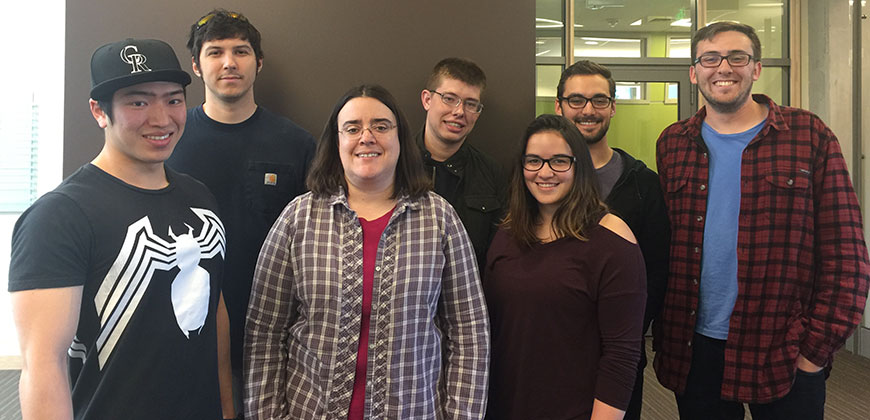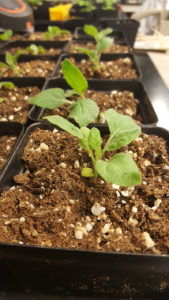
The plant-programming team: Bryant Hiraki, Eli McPherson, Christie Peebles (team faculty advisor), Aidan Ceney, Stacey Zintgraff, Cassidy Wright and Anthony Roulier.
A group of chemical and biological engineering students, advised by Christie Peebles, associate professor in the Department of Chemical and Biological Engineering, grow about 50 tobacco plants per week for their Senior Design project. The reason? Fighting viruses.
Through a process called agroinfiltration, plants can be genetically modified to produce monoclonal antibodies. These antibodies are naturally found in our immune system, and when a virus or infection is presented inside the body, the antibodies help our immune system kill the foreign invader. When we get a vaccine, for example, these same antibodies are created by the body dependent on the deactivated infection contained in the vaccine.
Neutralizing Japanese Encephalitis Virus
There are, however, different types of monoclonal antibodies – some are better equipped to fight different viruses. The Senior Design group is partnering with a microbiologist at the CDC who is doing research to neutralize Japanese Encephalitis Virus (JEV), an infection found in Asia and spread by mosquitoes. Currently, there is a vaccination available for JEV, but no treatments yet exist. Through this partnership, the students hope to produce monoclonal antibodies to treat JEV using the tobacco plants they have grown.

Tobacco is a model organism used by scientists to express and study a variety of proteins. Because tobacco rapidly produces proteins in high quantities, it is attracting attention from industry as an alternative means for monoclonal antibody production. The traditional method for producing monoclonal antibodies requires mammalian cell cultures, which is more expensive. Utilizing plants for this research could mean more than 50 percent savings on cost of goods, and the process itself is faster and easier to scale. The mammalian culture method also requires extra purification steps to ensure no viruses are present in the end product.
“What’s distinct about our project is that plant viruses aren’t transferrable to humans, in contrast to the prevailing method that uses mammalian cells,” said Cassidy Wright, senior chemical and biological engineering student.
Upstream, downstream, and quality control
The six students have outlined a design process to get to the end result of creating JEV-treating antibodies, and have split themselves into three teams to more effectively complete each step of the process.
The “upstream” team, Anthony Roulier and Eli McPherson, is responsible for identifying ways of increasing antibody production to yield the highest possible amount in the tobacco plant. The existing processes in plants can be “reprogrammed” to produce the desired antibody.
“Essentially what we’re doing is leveraging different machinery inside the plant to hijack its production system to create more of the protein of interest,” said Roulier.
Once the appropriate DNA is applied to the plant, it will produce JEV antibodies in place of the plant-based virus proteins. The “downstream” team, made up of Aidan Ceney and Cassidy Wright, is responsible for extracting the desired protein using affinity tags to isolate the correct protein. Then, the protein is verified as the correct antibody by the quality control and testing team, Stacey Zintgraff and Bryant Hiraki.
“The antibody for JEV is composed of two pairs of proteins – it’s Y-shaped, which helps us identify it. One pair of the proteins binds to JEV, while the other end of the antibody binds to parts of the body, which is what produces therapeutic effects,” said Hiraki.
Using the Y-shaped quality of the antibody to inform identification, the quality control and testing team has processes in place to confirm that at the end of the extraction process the correct antibody results.
A rewarding challenge
While the students have mapped out the three-stage process for growing the JEV-treating antibodies, completing each stage is a longer road that will likely require future Senior Design teams to complete. This year’s team will detail their design process, as well as present their findings thus far, at the E-Days Senior Design Showcase, April 14.
Though all six students had lab experience prior to beginning this project, Senior Design has been a positive, yet challenging learning experience for all.
“I worked in another lab for two years, but had never seen a project from beginning to end. With this team, you have to take much more of an aggressive approach, and it requires more initiative. I learned a lot about what goes into getting a project started,” said Zintgraff.